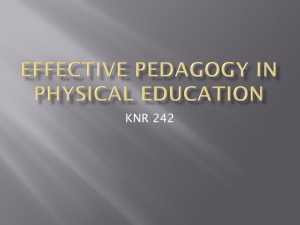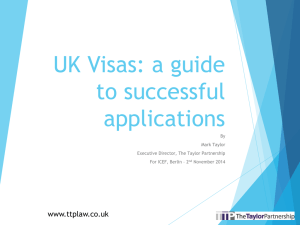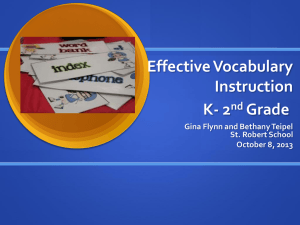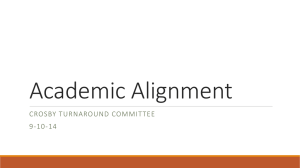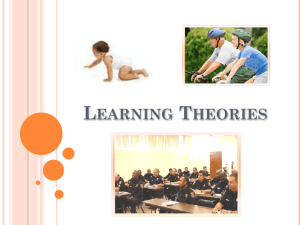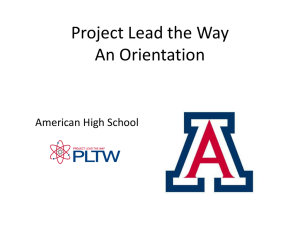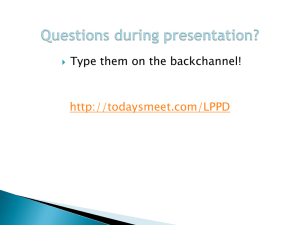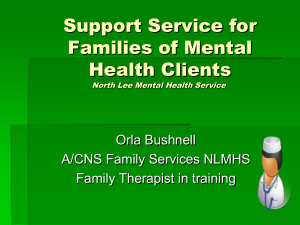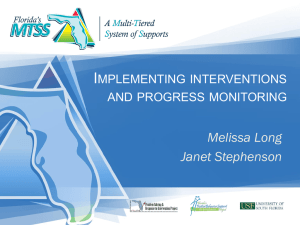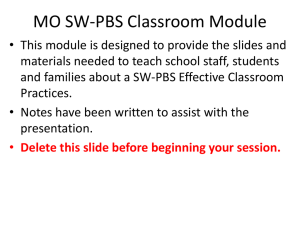Multi-tiered Systems of Support (MTSS)
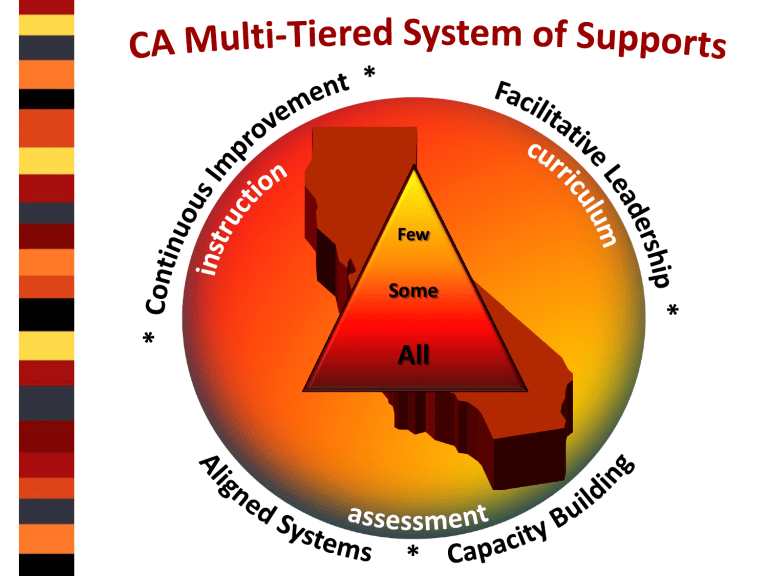
Few
Some
All
Multi-Tiered System of Supports
A Comprehensive Framework for
Implementing the
California Common Core State Standards
Professional Learning Module Series d
• Unit 1: What is a Multi-Tiered System of
Supports?
• Unit 2: Data-based Decision Making
• Unit 3: Instructional Planning and Supports
• Unit 4: Leadership for Implementation of
MTSS
Learning Objectives
By the end of this unit, you will be able to:
N
1. Identify elements of good Tier 1 classroom instruction
2. Define scaffolding and give examples of where it is addressed in the standards
3. State the purpose for differentiating instruction
4. Define Universal Design for Learning and its principles
5. Describe types of classroom accommodations that benefit all students
Review of Unit 2
Take Away Activity
• As you considered your own school or district setting
– What did you discover about how universal screening and progress monitoring occur?
– How is the information being used?
– Have staff members received training in the problem solving processes to make data-based decisions?
Quality of Classroom Instruction
• Single most important attribute for generating academic student growth
• Effective teacher has six to ten times as much impact on achievement as all other factors combined
– Family background, class size, socio-economic status, and peer group affiliation
• A strong predictor of eradicating poverty and ethnicity when teachers teach to a specific academic purpose
(Odden & Wallace 2003) (Mortimore & Sammons 1987) (Brock 2007)
Tier 1
• Foundation of the general education curriculum
• Scientific, research-based core instructional and behavioral practices and supports designed for all students
• Explicit and systematic
Direct Explanation
• Clearly stating the objectives for the lesson
• Identifying the specific core content and language objectives
• Defining the skills and strategies to be learned
Instructional Scaffolding
• Teacher modeling
– I do
• Guided practice and feedback
– We do
• Independent practice
– You do
Teacher Modeling
“I Do”
• The teacher
– Models by showing and telling a procedure or process
– Presents the model or example with a visual
• Photograph, illustration, video clip, graphic organizer, or diagram
– Ensures that the model is clear and aligned to the objective
– Uses student engagement
• Note taking, partner share, or echo response
Guided Practice and Feedback
“We Do”
• The teacher
– Allows time for both teacher and students to do it together using student engagement strategies
• Choral responding or open pair and share
– Gradually increases the number of steps students complete, while decreasing the amount of teacher prompts and scaffolding
Independent Practice
“You Do”
• The teacher
– Provides independent student practice
– Continually checks for understanding
– Monitors student progress
– Identifies those students who need more instruction
Time to Reflect
• Give an example of how a teacher would provide direct, explicit instruction following the gradual release of responsibility from the teacher to the students, using the “I do,” “We do,” and
“You do” approach
Instructional Scaffolding
• Gradual process in which teachers assist students with
– Incorporating new skills
– Learning by modeling
– Providing guided practice so the student will eventually be able to complete similar tasks independently
• Vygotsky’s Zone of Proximal Development
– The difference between what students can do
with direct assistance and what they can do
without assistance
(Vygotsky 1978)
Reading Standards for Literature
K–12
• By the end of the year, students will be able to
– Read and comprehend literature including stories and poetry in grades 2–3 text complexity band proficiently, with scaffolding as needed
(RL2.10; R:3.10)
Differentiated Instruction
• Consistently using a variety of evidence-based instructional approaches to transform materials, curriculum, and production in response to the interests, preferences, and readiness of academically diverse learners
• Way for teachers to think effectively about whom they teach, where they teach, and how they teach to maximize the students’ potential
(Hall, Stangman, & Meyer 2003)
Differentiation
• Content
– Change in the material being learned by the students
• Process
– The way in which the students access the material
• Product
– The way in which the student shows what he or she has learned
Flexible Grouping
• Purposeful reordering of students into working groups
• Ensure that all students work with a wide variety of classmates in a wide range of contexts
• Group membership can be organized by readiness, student interests, reading level, skill level, background knowledge, or social skills
Time to Reflect
• How does your school and/or classroom successfully meet the needs of all diverse learners?
• Within one content area that you teach, write down some ways that you might differentiate instruction with consideration of content, process, product, and flexible grouping
Differentiated Instruction
• Offers students multiple options for grasping information
• Affords a flexible approach to teaching that makes adjustments to both the curriculum and the presentation of information to the learners, as opposed to expecting the learners to adapt themselves to the curriculum
• Based on the foundation of Universal Design for Learning
(Hall, Tracey, Strangman, & Meyer 2003)
Universal Design for Learning (UDL)
• Set of principles for curriculum development
• Gives all individuals equal opportunities to learn by providing flexible approaches for creating instructional goals, methods, materials, and assessments that work for everyone
• Can be customized and adjusted for individual needs
• Uses multiple means of representation, expression, action, and engagement to plan curricula to meet the needs of all diverse learners
(www.cast.org)
Three Principles of UDL
Multiple Means of
Representation ff
Options for:
• Perception
• Language and symbols
• Comprehension
Multiple Means of
Action &
Expression ff
Options for:
• Expressive skills and fluency
• Executive functions
• Physical action
Multiple Means of
Engagement ff
Options for:
• Recruiting interest
• Sustaining interest
• Self-regulation
Examples of options for comprehension:
• Media
• Authenticity
• Graphic organizers
Examples of options for physical action:
• Project-based learning
• Demonstration
• Collaborative grouping
Examples of means of engagement:
• Flexible grouping
• Technology supports
• Offering choices
Universal Design for Learning
VIDEO: Universal Design for Learning http://www.youtube.com/watch?v=aaSZqgr2eUM
(Maryland Learning Link)
Time to Reflect
• Using the UDL Educator’s toolkit provided in your Unit 3 Participant Packet, note any examples you observed that demonstrated variation in:
– How information was represented
– How students demonstrated their understanding
– How students were engaged in learning
Universal Design for Learning
• Provide more students access to the general education curriculum
• Can impact
– The number of students requiring special education services
– The amount of time teachers spend individualizing instruction
– The number of accommodations needed during instruction and assessment
– The number of students dropping out of school
– The number of students not currently engaged in school
Commitment Evident in Standards
• “The standards should also be read as allowing for the widest possible range of students to participate fully from the outset, and as permitting appropriate accommodations to ensure maximum participation of students with special education needs.”
(ELA Standards, “What is Not Covered”)
Commitment to
English Learners
• “All students should be held to the same high expectations outlined in the Common
Core State Standards. This includes students who are English Language
Learners. However, these students may require additional time, appropriate instructional support, and aligned assessments.”
(ELA Standards, “What is Not Covered”)
Commitment to
Students with Disabilities
• “For students with disabilities, reading should allow for the use of Braille, screenreader technology, and other assistive devices , while writing should include the use of a scribe, computer, or speech-totext technology . In a similar vein, speaking
and listening should be interpreted broadly to include sign language .”
(ELA Standards, “What is Not Covered”)
Time to Reflect
Reflect on the Common Core State
Standards’ commitment to support English
Learners and students with disabilities
• How do these statements shift your thinking in terms of teacher knowledge of the core standards and current pedagogical practices?
Accommodations
• Practices and procedures that provide equitable access during instruction and assessment
• Minimize or eliminate barriers to the general education curriculum
• Do not change the expectation level or standard
• For all students
• Applied systematically at the beginning of curricular or assessment activities
(CDE 2010)
Types of Accommodations
• Presentation
– Allow students to access information in ways that do not require them to visually read standard print
• Response
– Allow students to complete activities, assignments, and assessments by using an assistive device or an organizer
• Setting
– May change the location in which a test or assignment is given or the conditions of the assessment setting
• Timing & Scheduling
– Allow an increased time allotted to complete an assessment or assignment
Time to Reflect
• Write down one example of an accommodation in each area of
– Presentation
– Response
– Setting
– Timing & Scheduling
Assistive Technology
Video: AIM Simply Said http://www.youtube.com/watch?v=6U3uKNKMv7s&feature=youtu.be
(National Center on Instructional Materials)
Time to Reflect
Consider how assistive technology support high expectations for students with disabilities in the classroom
• Give an example of an accessible instructional material
• List the four types of specialized formats
• How are the right formats chosen?
• What is one way that a student can interact with the content?
Re-Teach and Enrich
• School-wide strategy for providing additional support for students who are struggling with a concept
• Allows students who have mastered a concept to move on to the next level
Re-Teach and Enrich
• Grade level teams create and provide weekly formative assessments
• Identify both the students who are struggling with a learning objective, as well as the students who have mastered the same learning objective
Re-Teach and Enrich
Video
Reteach and Enrich: How to Make Time for Every
Student http://www.youtube.com/watch?v=J8DQugVxHv0
(Edutopia)
(edutopia.org)
Tier 2
Strategic Intervention
FOCUS
DESCRIPTION
• Students identified through screening as “at risk”
• Typically no more than 15% of the entire student population
INSTRUCTION
SETTING
• Targeted
• Evidence-based
• Supplemental to the core instruction
• Delivered in small groups
• General education classroom
• Another general education setting
- An intervention block
ASSESSMENTS • Progress monitoring
• Diagnostic
• Screening
(www.rti4success.org)
Tier 2
Strategic Intervention
• Elementary
– Small group instruction
(3-5 students)
– Instruction is targeted and skill-based
– Instruction in based on student needs, not on age or grade level
– 30 minutes in addition to the time allotted for the core instruction in
Tier 1
• Secondary
– Small group instruction
(10-16 students)
– Instruction is targeted and strategy-based
– Instruction is based on student needs, not on age or grade level
– 30-50 minutes in addition to the time allotted for content classes
(Kansas Guide to Learning Literacy 2012)
Tier 3
Intensive Intervention
FOCUS
INSTRUCTION
SETTING
ASSESSMENTS
DESCRIPTION
• Students who have not responded to primary or secondary level interventions
• Students with very low performance levels
• Typically only includes 3-5% of the entire student population
• Individualized
• Can be delivered to small groups or to an individual
• Intensified by making adaptations based on student data
• Either in the general education or special education classroom
• Progress monitoring
• Diagnostic
• Screening
• Should occur with greater frequency to determine which instructional adaptations may be needed
(www.rti4success.org)
Tier 3
Intensive Intervention
• Elementary
– Small group instruction
(1-3 students)
– Instruction is based on student needs, not on age or grade level
– 60 minutes (or two 30 minute sessions) in addition to time allotted for core instruction in Tier 1
• Secondary
– Small group instruction
(1-4 students)
– Instruction is based on student needs, not on age or grade level
– 60 minutes (or two 30 minute sessions) in addition to the time allotted for core instruction in Tier 1
(Kansas Guide to Learning Literacy 2012)
Time to Reflect
• What are two similarities between strategic, tier 2 supports and intensive, tier
3 supports?
• What are two differences between strategic, tier 2 supports and intensive, tier
3 supports?
Resources
(www.rti4success.org) www.rti4success.org
Take Away Activity
• Consider the instructional readiness elements in your setting
– Are staff members selecting academic curricula, behavioral instructional materials, and programs that will meet the needs of all students?
– Are staff members specifically trained in using the academic and behavioral core, supplemental, and intensive curricular materials and programs that they are responsible for providing?
– Does the schedule provide sufficient time for core, supplemental, and intensive instruction?
Time to Reflect
• What did you learn in Unit 3?
• What questions do you have?
Unit 4 Preview
• Leadership
– What role does leadership play in initial implementation and sustainability?
– How can districts and school sites establish self-correcting feedback loops to support implementation?
